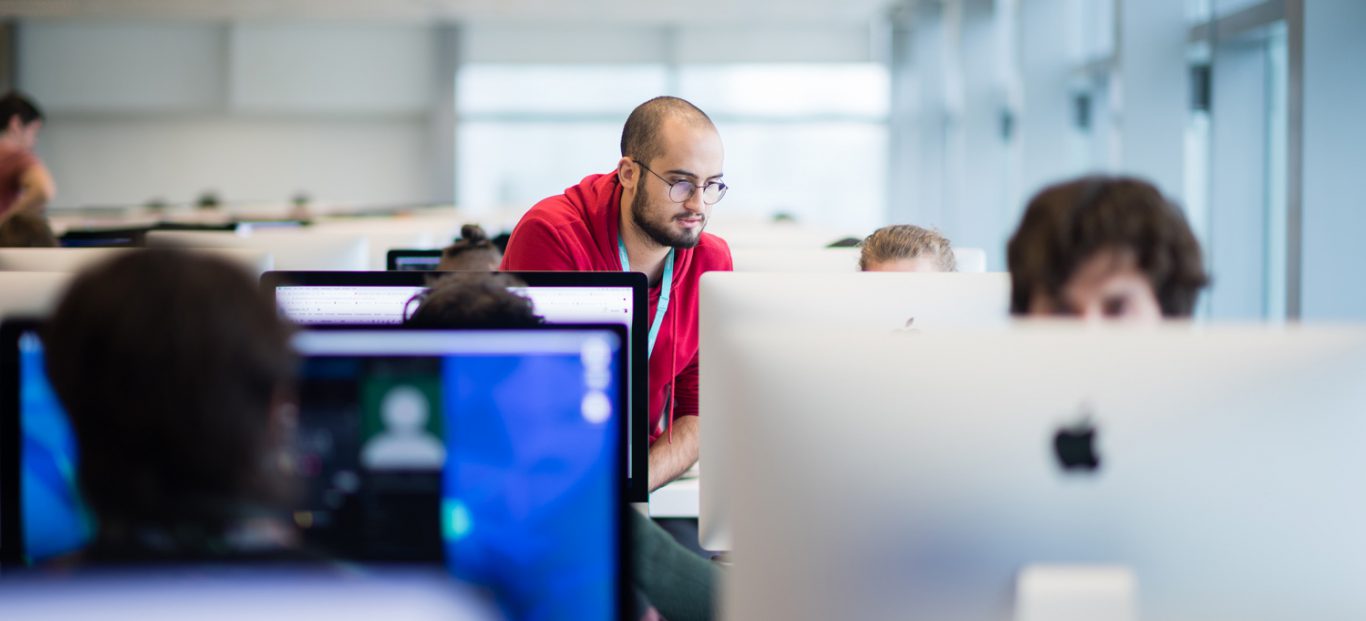Latest News42 Madrid
Is it possible to combine 42 Madrid with a job?
This is one of the top questions that arrive in the mailbox of 42 Madrid and the answer is always the same: It depends solely on the students themselves. The 42 methodology is based on them managing their own time, putting them at the centre of learning. Each person chooses when to study and at what pace.

Organising tasks and establishing work routines to deliver projects on time are part of the 42 Madrid learning experience. The profiles of students who combine employment with on-campus training are heterogeneous. For all of them, it is demanding to combine both occupations, but by no means impossible. Previous experience from other campuses warned that the first stages were more complex, but once the routines have been adjusted, the learning curve is continuous and even exponential. The pool is a different story as it is an even more demanding period and requires spending many hours programming and working with the rest of the candidates on a daily and uninterrupted basis. It is unfeasible to progress along the training pathway of the latter entrance exam if time and effort is not devoted to peer-to-peer work.
Facu is 24 years old and arrived in Valencia two years ago from Argentina. In his home country, he had studied mechanical engineering for three years until he decided not to continue: “The career had few resources and a strong theoretical component, with hardly any practical training. There was no creativity, just the opposite of 42,” he says. With just enough money to be able to start a new life in another city, he moved to Madrid after overcoming the pool. He had no accommodation, no acquaintances and no job to support himself. Fortunately, within two weeks of starting the course, he found a 20-hour-a-week job as a waiter near Distrito Telefónica, which allows him to lead the life he needs to keep up at the academy. During the week, he spends an average of six hours a day on a split schedule, some in the morning and some in the afternoon. At the weekend, Facu is also productive and devotes a few more hours to it. His priorities are clear and he is in Madrid to be trained, nothing else. A part-time job is what allows him to do this. “I am not closed to any possibility in the digital professions, but I would like to explore the entrepreneurial pathway by combining a specialisation as a data scientist with administration and finance,” he states.
Cristina is the head of infrastructure at her company, where she started working five years ago. She is in charge of the network, the computer pool, incidents with the OS, the applications or the networks between the different sites. “I spend at least 40 hours a week there and my colleagues are like my family, very similar to what I find in 42 Madrid. I started with an internship as part of an unemployment course, and I never left”, she explains. Without a shadow of a doubt, Cristina perfectly represents the attitude and perseverance that the 42 methodology demands. On weekdays, she usually attends the campus four days a week for an average of three hours per day. To this she adds another six or seven hours on Saturdays. This effort is motivated by the expectation that her digital skills will evolve to position her in an advantageous position in the labour market. Like Facu, she is interested in a specialisation related to data, although she is also interested in web programming.
With a degree in Industrial Engineering and an internship contract, Raúl joined Fundación Telefónica in 2017. He has been a member of staff for more than a year now and works in data management in the Digital Transformation department. He recalls “I was fortunate that Fundación Telefónica made my timetable flexible so that I could do the pool. Otherwise, it would have been impossible. Now, as a student, it is up to me to manage my dedication to projects without affecting my professional performance”. Many profiles like Raul’s, with official qualifications, are looking for new competences and skills in 42 that they cannot find in formal education, either because of the inflexibility of the contents or the schedule. In addition, given the lack of similar content in his school, his curiosity and motivation led him to also train as a data scientist, where he became familiar with the Python programming language. This attitude of continuous learning throughout his professional career led him to successfully attempt to become a student of 42 Madrid. “It is very clear to me that I want to continue combining both occupations, but it is complicated since it makes you have your mind very involved in two different things to which you give great importance. In my case, I go at a slow but steady pace. Of course, I usually come to 42 Madrid at weekends,” he adds.
In short, is it possible to combine a job with training at 42 Madrid? Cristina sums it up perfectly and dares to share her advice: “During the pool, plan your holidays, this is very important. In my case, I set aside a year’s holiday. Furthermore, accept that you are going to have to ask for time every now and then to attend an event that you don’t want to miss. And only if you really want it and are interested, you will succeed. Even today, there are days when I wake up at 5.30 in the morning and wonder if this is worth it or if I’m crazy and that’s it, but I have to try because it’s my career path. Just like everyone else, I have my bad days, but once I get to the 42 Madrid campus, all the bad feelings go away. That is really what I want to achieve, that my professional future be like this for my whole life.
By Eduardo Santana
